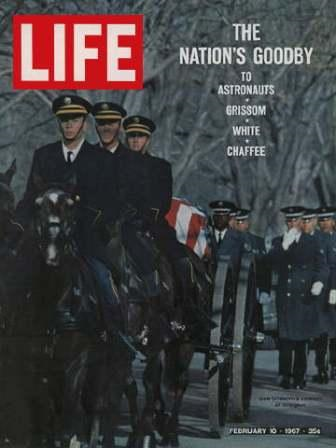Out from the ashes
2017-01-20
“We built a new spacecraft from the ashes of Apollo 1, and here 21 months later we’re flying people to the moon.” Jerry C. Bostick, Flight Dynamics Officer, Mission Control Center (Gemini and Apollo Programs)
It was to have been just an ordinary dress rehearsal on the launch pad. But instead, in an instant, it was a tragedy.
NASA astronauts Gus Grissom, Edward White and Roger Chaffee were strapped in their seats in their command module atop a Saturn IB rocket. Their mission would test this new spacecraft in Earth orbit. All future Apollo crews would rely on this capsule to see them safely on their journeys to and from the moon.
At 6:31 p.m., the vehicle rocked twice as the alarm “Fire!” rang out from inside the capsule.
Pad personnel scrambled to reach the White Room just minutes after, but it was too late. All three astronauts had perished after inhaling carbon monoxide and other toxic gases generated by the flash fire.
At the Manned Spacecraft Center in Houston, now NASA’s Johnson Space Center, Flight Director Gene Kranz told his team: “From this day forward, Flight Control will be known by two words: ‘tough’ and ‘competent.’ ‘Tough’ means we are forever accountable for what we do or what we fail to do. ‘Competent’ means we will never take anything for granted.”
An accident review board later determined that the fire was caused by an electrical arc in an equipment bay following a momentary power outage. The investigation led to major design and engineering changes, making the Apollo spacecraft safer for the coming journeys to the moon.
As time passes, we unintentionally distance ourselves from this event that shaped the history of NASA and our loftiest goal at the time: getting humankind on the moon. Yet here in 2017, we again find ourselves in a familiar scenario. We have a capsule. We have a target. And we are testing the Orion spacecraft to carry humankind farther into the depths of the solar system.
Same story—but different people, different parts and a different age.
Hindsight could be clarifying.
What on Earth were we thinking?
“The cabin was pressurized with oxygen at five pounds of pressure above atmosphere,” Frank Samonski, chief of the Apollo Command Module Environmental Control Systems Section, said in his Johnson Space Center oral history interview. “So it was 19.7 pounds per square inch of oxygen, pure oxygen. Almost anything will burn in that environment and burn vigorously. How it is we got to that situation where we did that as a procedural thing, I’ll never know.”
In his interview, Samonski said the team believed there was a need for the crew to “denitrogenate” should they need to exit the vehicle for an emergency spacewalk. If that were to occur shortly after launch, the crew could have experienced “the bends” since they would’ve had nitrogen in their bodies. The workaround? Pure oxygen.
“So a number of things kind of piled up, really, that was the cause for that fire,” Samonski said. “Materials, control of nonmetallic materials, there virtually wasn’t very much control, and there was just too many flammable things in the spacecraft. That’s another thing we fixed after the fire.”
NASA fixed a lot of things.
Kraft said, “George Low comes in the middle of that and brings order out of chaos.”
Low immediately appointed a board, the Configuration Control Board, and appointed all of the top managers at the Manned Spacecraft Center as board members. As he began to get a hold of the program, he “brought the program back up into a place where I think it was obvious that it was healing, and that what had to be done with the hardware … We had a meeting shortly after he became the program manager and listed all of the things that everybody wanted done to fix the vehicles, to fix the management, to fix the rockets, to fix everything that had to be done. We made a list of all those things. There were 125 top ones. We characterized them as absolutely required,” Kraft said.
It must have been considered cathartic that, a year later, the team was doing every one of them to make Apollo right—and safe.
A change—or many—could do you good
“In retrospect, it was in front of us; and there it was,” said Glynn Lunney, a flight director. “It (was) just something we had gotten used to and didn’t recognize it for the danger that it was.”
Lunney was speaking about the pure oxygen environment.
In the ‘60s, spaceflight was progressing at a rapid clip. People were hungry for discovery, for the moon.
“I remember a lot of the tests that were conducted were difficult … things would go wrong,” Lunney said. “The test would have to hold, the crews would get frustrated—and so on. The problem with that is that it induces people to try and solve the problems and get on with it; and therefore, they probably did not want to spend too much time or consider all the risks that might not have been identified, such as the pure O2 environment.”
Changes were not only in store for the command module. They also permeated to the lunar module, launch and ground systems, and software.
“People came back to work with a renewed sense of dedication, a kind of a ‘I don’t want that to happen again, and I certainly don’t want it to happen in the area I’m working on, that I’m responsible for,’” Lunney said.
It also changed the safety culture. Before Apollo 1, there was no separate entity providing oversight for human spaceflight’s inherently hazardous operations. Robert Gilruth, director of the Manned Spacecraft Center at the time, created an integrated Safety, Reliability and Quality Assurance organization that had a direct line of report to him.
Though the list of items to get Apollo back flying was daunting, it represented the agency really asking “What if …?” and then meticulously addressing each concern. Some of the upgrades included redesigning the hatch from an inward-opening to an outward-opening hatch; wrapping the plumbing; changing the insulation on the wiring; going with new materials for the vehicle; enhancing the suit design make it less flammable; and switching the spacecraft environment to a 60/40 oxygen/nitrogen mix.
One thing that couldn’t be helped, though, was the food.
“Food has to be flammable,” said Paul Lachance, a Flight Food and Nutrition coordinator in the Crew Systems Division. “You’ve got to have something that will digest, so it’s got to be burnable.”
Lachance recalled how Frank Borman, head of the astronaut investigators, came to him and said, “You’ve got to do something about the food.”
Lachance knew that Borman was, well, asking for the moon.
“You give me stainless-steel astronauts, and I’ll give you stainless-steel food,” was Lachance’s retort.
Borman understood right away that he wasn’t going to magically change his body composition, or that of his peers. However, they did reinforce the doors to the food compartment and make them a little tighter.
What they could do to mitigate risk, they did.
Many at NASA believed that if the fire on the pad hadn’t happened, they probably wouldn’t have made it to the moon.
“It was just a lesson that kind of had to be learned,” Samonski said, “and it was maybe just fortunate that we learned it early, and we (learned) it on the ground.”
Editor’s Note: This article has been edited to reflect that the quotes taken from Mr. Samonski were from his JSC oral history interview, not a personal interview, and to better clarify why oxygen was used in the capsule. To read Mr. Samonski’s interview, or the interviews of other NASA engineers, scientists and astronauts, please visit our NASA JSC Oral History site.
Catherine Ragin Williams
NASA Johnson Space Center
It was to have been just an ordinary dress rehearsal on the launch pad. But instead, in an instant, it was a tragedy.
NASA astronauts Gus Grissom, Edward White and Roger Chaffee were strapped in their seats in their command module atop a Saturn IB rocket. Their mission would test this new spacecraft in Earth orbit. All future Apollo crews would rely on this capsule to see them safely on their journeys to and from the moon.
At 6:31 p.m., the vehicle rocked twice as the alarm “Fire!” rang out from inside the capsule.
Pad personnel scrambled to reach the White Room just minutes after, but it was too late. All three astronauts had perished after inhaling carbon monoxide and other toxic gases generated by the flash fire.
At the Manned Spacecraft Center in Houston, now NASA’s Johnson Space Center, Flight Director Gene Kranz told his team: “From this day forward, Flight Control will be known by two words: ‘tough’ and ‘competent.’ ‘Tough’ means we are forever accountable for what we do or what we fail to do. ‘Competent’ means we will never take anything for granted.”
An accident review board later determined that the fire was caused by an electrical arc in an equipment bay following a momentary power outage. The investigation led to major design and engineering changes, making the Apollo spacecraft safer for the coming journeys to the moon.
As time passes, we unintentionally distance ourselves from this event that shaped the history of NASA and our loftiest goal at the time: getting humankind on the moon. Yet here in 2017, we again find ourselves in a familiar scenario. We have a capsule. We have a target. And we are testing the Orion spacecraft to carry humankind farther into the depths of the solar system.
Same story—but different people, different parts and a different age.
Hindsight could be clarifying.
What on Earth were we thinking?
“The cabin was pressurized with oxygen at five pounds of pressure above atmosphere,” Frank Samonski, chief of the Apollo Command Module Environmental Control Systems Section, said in his Johnson Space Center oral history interview. “So it was 19.7 pounds per square inch of oxygen, pure oxygen. Almost anything will burn in that environment and burn vigorously. How it is we got to that situation where we did that as a procedural thing, I’ll never know.”
In his interview, Samonski said the team believed there was a need for the crew to “denitrogenate” should they need to exit the vehicle for an emergency spacewalk. If that were to occur shortly after launch, the crew could have experienced “the bends” since they would’ve had nitrogen in their bodies. The workaround? Pure oxygen.
“So a number of things kind of piled up, really, that was the cause for that fire,” Samonski said. “Materials, control of nonmetallic materials, there virtually wasn’t very much control, and there was just too many flammable things in the spacecraft. That’s another thing we fixed after the fire.”
NASA fixed a lot of things.
Kraft said, “George Low comes in the middle of that and brings order out of chaos.”
Low immediately appointed a board, the Configuration Control Board, and appointed all of the top managers at the Manned Spacecraft Center as board members. As he began to get a hold of the program, he “brought the program back up into a place where I think it was obvious that it was healing, and that what had to be done with the hardware … We had a meeting shortly after he became the program manager and listed all of the things that everybody wanted done to fix the vehicles, to fix the management, to fix the rockets, to fix everything that had to be done. We made a list of all those things. There were 125 top ones. We characterized them as absolutely required,” Kraft said.
It must have been considered cathartic that, a year later, the team was doing every one of them to make Apollo right—and safe.
A change—or many—could do you good
“In retrospect, it was in front of us; and there it was,” said Glynn Lunney, a flight director. “It (was) just something we had gotten used to and didn’t recognize it for the danger that it was.”
Lunney was speaking about the pure oxygen environment.
In the ‘60s, spaceflight was progressing at a rapid clip. People were hungry for discovery, for the moon.
“I remember a lot of the tests that were conducted were difficult … things would go wrong,” Lunney said. “The test would have to hold, the crews would get frustrated—and so on. The problem with that is that it induces people to try and solve the problems and get on with it; and therefore, they probably did not want to spend too much time or consider all the risks that might not have been identified, such as the pure O2 environment.”
Changes were not only in store for the command module. They also permeated to the lunar module, launch and ground systems, and software.
“People came back to work with a renewed sense of dedication, a kind of a ‘I don’t want that to happen again, and I certainly don’t want it to happen in the area I’m working on, that I’m responsible for,’” Lunney said.
It also changed the safety culture. Before Apollo 1, there was no separate entity providing oversight for human spaceflight’s inherently hazardous operations. Robert Gilruth, director of the Manned Spacecraft Center at the time, created an integrated Safety, Reliability and Quality Assurance organization that had a direct line of report to him.
Though the list of items to get Apollo back flying was daunting, it represented the agency really asking “What if …?” and then meticulously addressing each concern. Some of the upgrades included redesigning the hatch from an inward-opening to an outward-opening hatch; wrapping the plumbing; changing the insulation on the wiring; going with new materials for the vehicle; enhancing the suit design make it less flammable; and switching the spacecraft environment to a 60/40 oxygen/nitrogen mix.
One thing that couldn’t be helped, though, was the food.
“Food has to be flammable,” said Paul Lachance, a Flight Food and Nutrition coordinator in the Crew Systems Division. “You’ve got to have something that will digest, so it’s got to be burnable.”
Lachance recalled how Frank Borman, head of the astronaut investigators, came to him and said, “You’ve got to do something about the food.”
Lachance knew that Borman was, well, asking for the moon.
“You give me stainless-steel astronauts, and I’ll give you stainless-steel food,” was Lachance’s retort.
Borman understood right away that he wasn’t going to magically change his body composition, or that of his peers. However, they did reinforce the doors to the food compartment and make them a little tighter.
What they could do to mitigate risk, they did.
Many at NASA believed that if the fire on the pad hadn’t happened, they probably wouldn’t have made it to the moon.
“It was just a lesson that kind of had to be learned,” Samonski said, “and it was maybe just fortunate that we learned it early, and we (learned) it on the ground.”
Editor’s Note: This article has been edited to reflect that the quotes taken from Mr. Samonski were from his JSC oral history interview, not a personal interview, and to better clarify why oxygen was used in the capsule. To read Mr. Samonski’s interview, or the interviews of other NASA engineers, scientists and astronauts, please visit our NASA JSC Oral History site.
Catherine Ragin Williams
NASA Johnson Space Center
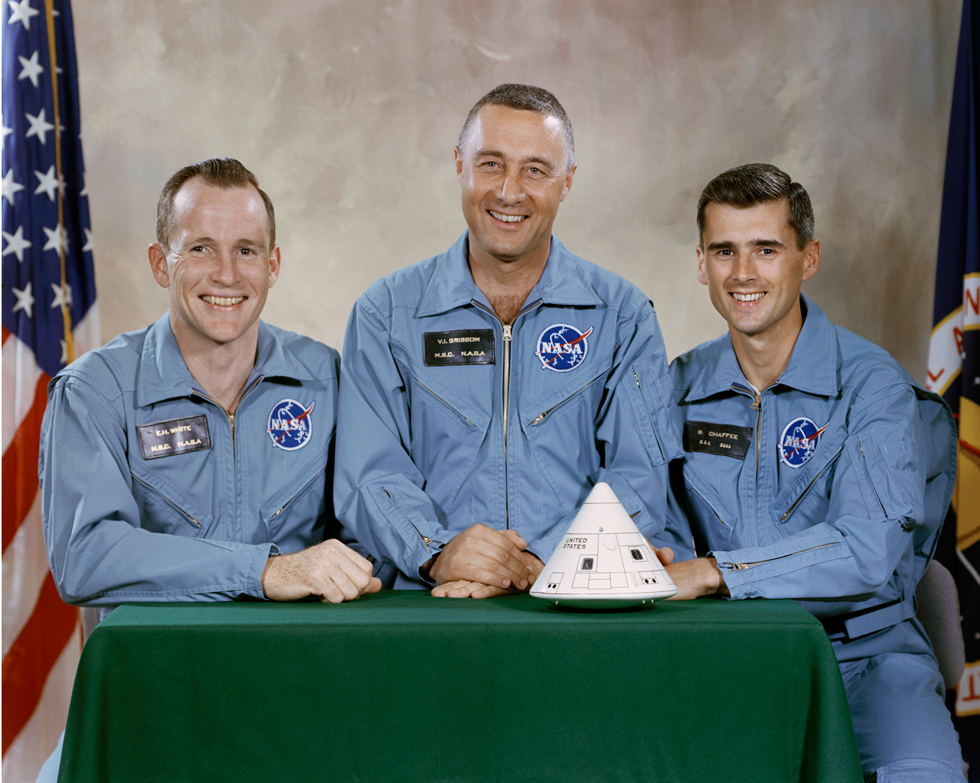
The Apollo 1 crew, from left: Edward H. White II, command module pilot; Virgil I. Grissom, mission commander; and Roger B. Chaffee, lunar module pilot. Image Credit: NASA
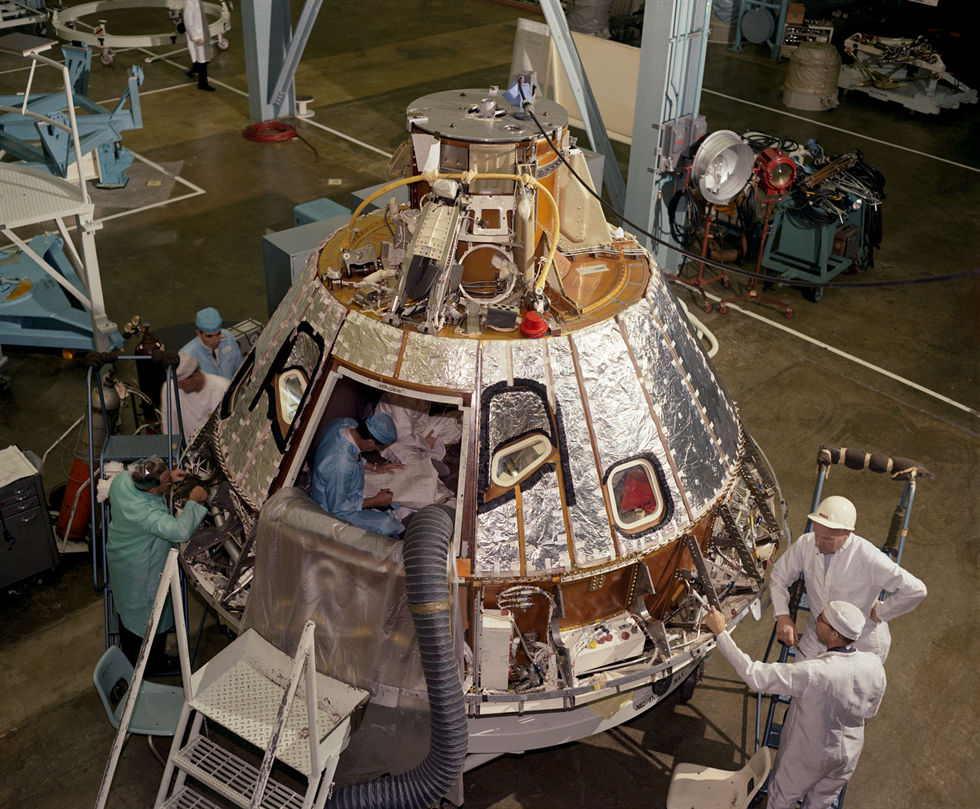
High angle view of the Spacecraft 012 Command Module, looking toward -Z axis, during preparation for installation of the crew compartment heat shield, showing mechanics working on aft bay. Image Credit: NASA
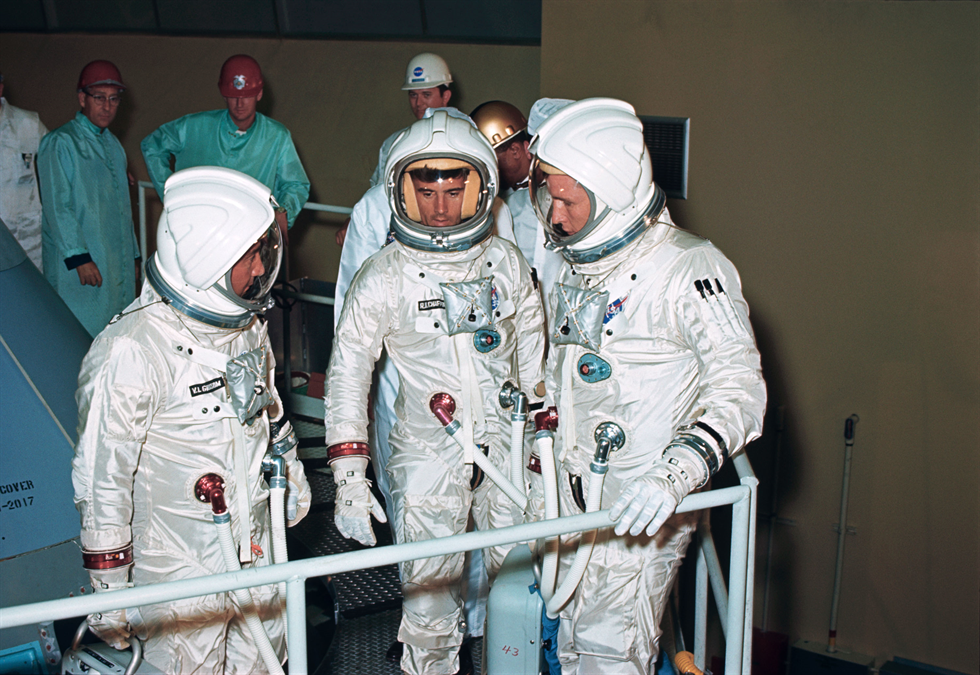
The three crew members check out the couch installation on the Apollo Command Module. From left are Grissom, Chaffee and White. Image Credit: NASA
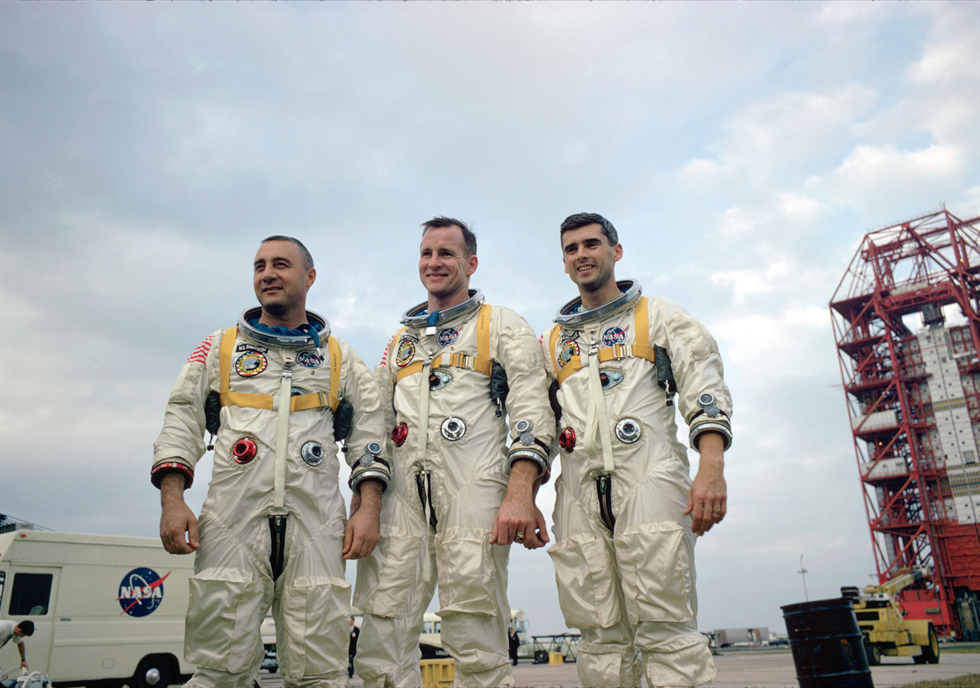
The prime crew pictured during training in Florida. From left are Grissom, White and Chaffee. Image Credit: NASA
